Ireland & Britain
England & Scotland
Travel Stories
Interests & Hobbies
Outdoors & Activities
Advice for Visitors
About My Ireland Tour
News & What's On

Ireland's warmest and driest region is also one of its most popular vacation destinations. Visitors to Kilkenny and the South East enjoy the quaint and picturesque seaside towns and fishing villages that typify this corner of the Emerald Isle. As with Wicklow to the north, Ireland's ancient history is strongly felt here, and the ruins of castles, churches and abbeys are likely to feature on most local tour itineraries. Use this page to find the South East most popular tourist destinations, as well as delving deeper into its hidden treasures.
The main attraction of the South East, for Irish people at least, is the more stable weather of the region. During the summer months, you'll find the beaches of Waterford and Wexford to be hives of activity.
History plays a large part in the formation of the other, non-seasonal, attractions of the South East. Ancient Christian settlements, medieval castles & towns are dotted throughout. The jewel in the crown here though, if you'll pardon the pun, is the House of Waterford Crystal—a tour through the world's most famous Crystal makers.
Ireland has more than its fair share of outstanding archaeological sites, but the Rock of Cashel is arguably the most impressive. The 'rock' from which it takes its name is, in fact, a limestone hill, covered in luscious green, rising from the plain which characterises the surrounding area. The word 'cashel', by contrast, is derived from the Irish Gaelic word caiseal, meaning stone fortress.
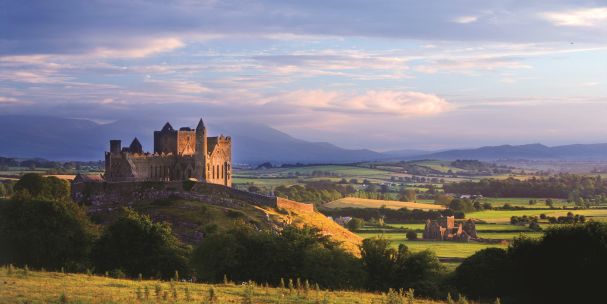
In both respects, the Rock of Cashel lives up to its title. The rock itself is vast and imposing, and one can only imagine the difficulties it would have posed for attackers throughout the ages who had designs on the stone fortress above. The masonry of the fort itself is no less spectacular and is remarkably well preserved almost a full millennium after its original construction.
The history of the site itself is long and varied. First used as a base for Welsh invaders, the Eóghanachta clan, who would become kings of this region of Ireland. The clan, and hence the rock, have been closely associated with St. Patrick (considered by many historians to be a Welshman), earning Cashel's pseudonym, St. Patrick's Rock.
Although under Eóghanachta rule, Cashel would rival Tara as Ireland's centre of power, it was wrested from their control in the Tenth Century before being presented to the Church in 1101. The site would change hands many times again in the centuries to follow, giving rise to the various buildings whose remains now occupy it.
Have a look across the fields surrounding the Rock of Cashel and enjoy the stunning views. You will be able to see the ruins of Hore Abbey.
One of the highlights is Cormac's Chapel, a beautiful example of Romanesque architecture. Access to the chapel is by guided tour only and lasts 45 mins.
The Rock of Cashel is just a five-minute walk from Cashel town. This is a busy site and might get very busy during the summer months. We would recommend that you spend between 1 to 1.5 hours at the Rock of Cashel. Public toilets are located at the car/coach park nearby.
Opening hours from early June to mid-September are from 09:00 to 19:00.
Opening hours from mid-March to early June & mid-September to mid-October are from 09:00 to 17:30.
Opening hours from mid-October to mid-March are from 09:00 to 16:30.
Tickets are €8 for an adult and €4 euro for a child. A guided tour of Cormac's Chapel costs €3 extra and needs to be booked at the entrance.
Waterford Crystal is known the world over for its quality and, throughout a history that dates back to its establishment in the South-East of Ireland in 1783, it has been a landmark of its own in this part of Ireland. Today, Waterford Crystal is no less recognisable than its sister brands, Wedgewood and Royal Doulton.
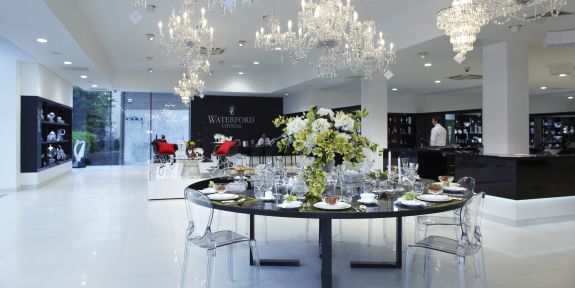
The visitor centre is a modern building on The Mall, a tour of which teaches visitors how crystal is made. Undoubtedly the most popular part of the tour is the blowing room, where the crystal glasses, vases, etc. are 'blown' into shape.
The visitor centre has a nice little café and is fully wheelchair accessible.
The large modern complex houses the factory, a cafe and retail shop. The tour of the factory takes 90 minutes and ends in the shop. A factory tour does not need to be booked ahead (unless your group is bigger than 15 people).
The hours of the factory tour from January to February and November to December are 9:30 to 15:15. There are no factory tours on Saturdays and Sundays.
The hours of the factory tour in March are 9:30 to 15:15 from Monday to Sunday.
The hours of the factory tour from April to October are 9:30 to 16:15 from Monday to Sunday.
Admission to the House of Waterford Crystal is €16.50 for adults, €8.50 for a child (10 -18 years old). Children under 10 go free.
A picture-postcard Irish destination found on the banks of the River Nore, Kilkenny has all the charm and history you could ask for. An ancient setting, with its castle and cathedral, it is home to many equally ancient pubs, where good craic and good live music are assured. Kilkenny also has a great selection of restaurants to choose from. The Medieval Mile, connecting the 13th century St. Canice's Cathedral and the 12th century Kilkenny Castle, lets you chart a journey through the city while exploring its beginnings.
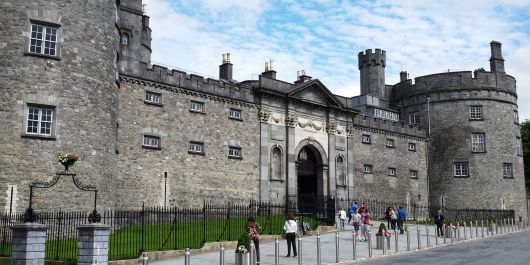
The city is a real hidden gem: although many first-time visitors don't put it at the top of their 'must-see' list, almost everyone who travels here is glad that they made the journey. Kilkenny, in recent years, has gained a reputation as one of Ireland's more cosmopolitan cities. During the summer months, there are endless festivals and general goings-on to enjoy.
Getting to Kilkenny Tourist Office. Head for Market Cross car park. Turn right at the main exit and walk straight down Parliament Street, then continue straight onto High Street. In three minutes, you will reach Kilkenny Tourist Office.
Like the Rock of Cashel, Tintern Abbey owes its heritage to Wales, founded as it was by the Earl of Pembroke in the Thirteenth Century for the benefit of its Welsh monk inhabitants. Today, there remains a Welsh counterpart with the same name. The abbey became the living quarters of the Colclough family in the 16th century and has a long history as a private residence. 45-minute guided tours of the property are available.
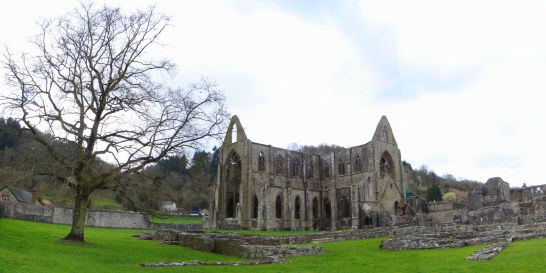
Much of the original building still stands, including the cloister walls and crossing tower, as well as the chancel and transept chapels. But visitors will enjoy the surroundings at least as much as the abbey itself, with lakes, streams, woods and ruins providing distractions for all age groups. Perhaps most alluring of all is the Colclough Walled Garden, built over 200 years ago and restored since 2010. During these restorations and conservations works, special measures have been taken to protect local bat colonies.
Break up the beautiful walks around the walled gardens with a visit to the tea rooms for coffee and waffles.
Tintern abbey is located 16 km south of New Ross and 29 km from Wexford. The recommended duration for a visit is 1 to 2 hours.
The abbey is closed from November to March and open daily from April to the end of October.
Opening hours are 10:00 to 17:30 from June to August and 09:30 to 17:00 in April, May, September and October.
You can purchase tickets to Tintern Abbey and Colclough Walled Garden at the reception. Admission to Tintern Abbey is €5 for adults, €4 for Senior Citizen/Group, €3.00 Child/Student and €13 for a family. Combined tickets to Tintern Abbey and Colclough Walled garden can be purchased as well at €9.
One of Europe's oldest cities with a rich Viking heritage, today's Waterford retains its charming old-world feel. Its intersecting narrow streets and alleyways lead visitors on mini journeys of discovery as they explore. As well as the well-known House of Waterford Crystal, visitors should look out for the Waterford Treasures museums: the Medieval Museum, Reginald's Tower and Bishop's Palace.
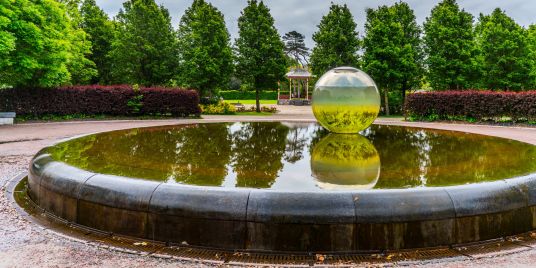
A must-see destination for all foodies visiting Ireland, Dungarvan is home to the regular farmers' market, the Waterford Festival of Food, and the Tannery Restaurant and Cooking School.
Only a short walking distance or short cycle from Waterford City, you will find the Waterford Greenway. This cycling and walking route follows the old railway lines along the coast. You can rent a bicycle in Waterford City to explore the 46 km route and discover the many attractions and stops along the way.
Head for the long Waterford quay and find a nice spot for lunch with a view over the harbour.
The Glen of Aherlow is a valley found in the western part of County Tipperary, between the Slievenamuck and Galtee Mountains. The main village of the valley is Lisvarrinane. The Irish poet and Catholic priest Geoffrey Keating took refuge in the caves of the valley while on the run and writing his masterpiece 'Foundation of Knowledge on Ireland'.
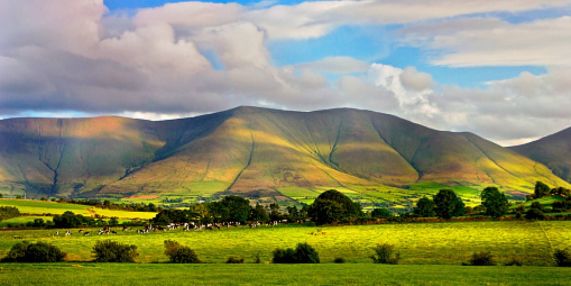
Keen walkers and occasional strollers will be equally glad they looked up the eight looped walking trails that are marked here. Five of these start at the Christ the King Trail Head. The rest all begin at Lisvarinane Village Trail Head. Distances range from one mile to four miles.
The car park at the popular 'Christ the King' statue can get quite busy during the summer, but it is from here that the best views of the glen and valley can be enjoyed.
The Swiss Cottage is located near the town of Cahir in County Tipperary. It was built around 1810 by Richard Butler, the first Earl of Glengall—who later went on to marry Emily Jeffereys of Blarney Castle. The cottage was a part of the estate of Lord and Lady Cahir and gets its name due to its resemblance to an Alpine cottage. The most striking feature of the Swiss Cottage is its traditional thatched roof. The woodwork, on the exterior of the cottage, was designed to resemble tree branches. The interior features a spiral staircase and colourful, nature-inspired décor. The salon is decorated with wallpaper manufactured by the Dufour factory.
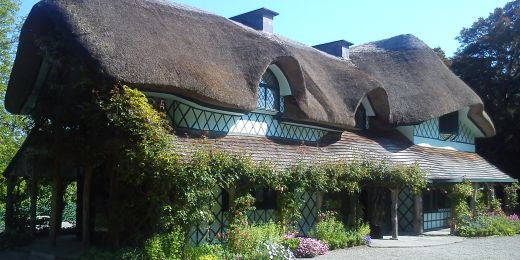
During the 19th century, the cottage was used by the local gentry as a place where they could, in one of the stranger pass times of the times, live as peasants. Judging by the lavish interior of the cottage, in comparison with the homes that actual peasants would have lived in, the gentry were a long way off finding realism here. The Irish Georgian Society restored the cottage in 1985 and was opened to the public in 1989 as a historic house museum.
It is worth noting, any groups of ten people or more must be pre-booked. If you have a little more time, Cahir Castle is a seven-minute drive from the Swiss Cottage. There, you can book a guided tour or simply soak in the scenic sense of history.
A 30-minute walk, called Coronation Walk, along a riverside path will lead you to Cahir Castle.
The Swiss cottage can be found 2 km south of the Heritage Town of Cahir. Entrance to the cottage is by a guided tour only, lasting 30 minutes. During the summer this is a very busy site.
Open from mid-March to October from 10:00 to 17:00.
An adult will pay €5 and a child €3. All groups of 10 or more have to be pre-booked.
Dunmore East is a fishing village in County Waterford. It is located in an area that saw a huge influx of Norman and Viking invaders and eventually settlers (circa 795-1170 B.C). There are mentions of the village being active as a fishing port as far back as 1745. At the time, the homes of the fishermen were mainly located in the Lower Village. A historical document, from 1776, mentions that there was a fishing fleet of as many as fifty boats working off the coast.
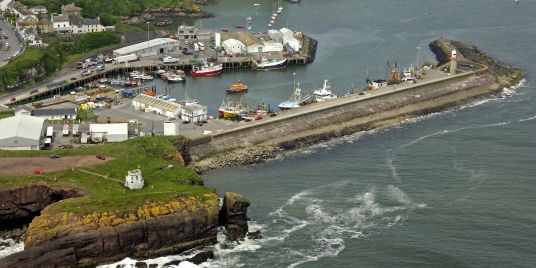
In 1812, the British government made the decision to locate a new landing port for passengers and mail, coming from England to Ireland, in Dunmore East. The construction of the pier took until 1837 to complete, at a cost of £108,000. By then the decision was made to have the Royal Mail station relocated to Waterford City. Today, Dunmore East is a thriving village, buoyed mainly by fishing throughout the year and by tourism in the summer, thanks in part to the huge number of cruise liners that dock there.
Arrive with an empty stomach: Dunmore East is known for its fabulous food and drink. If you like seafood, you won't find much better or much fresher than this.
The 18th-century is perhaps one of the most formative times in the history of Western democracy. It is also one of the bloodiest. The American and French revolutions would have a significant effect on the Irish sense of identity, not to mention the revolutionary spirit which ran through it.
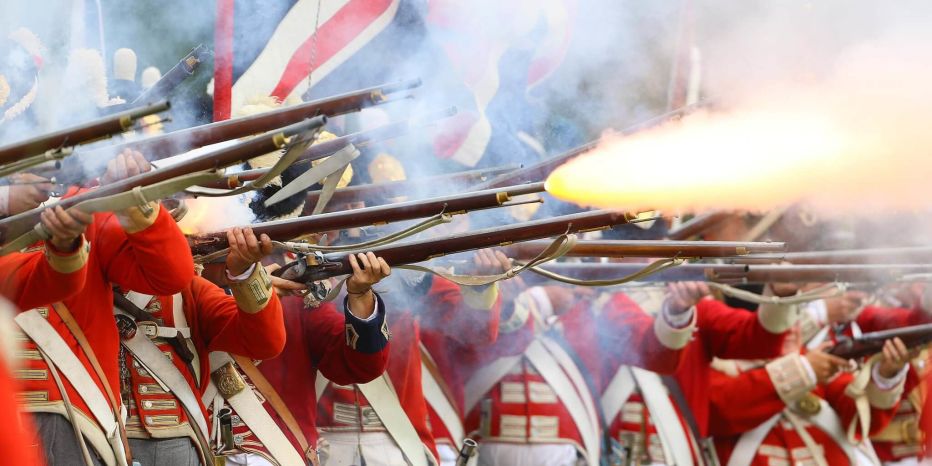
The 1798 Rebellion Centre charts the history of the attempted revolution of that year, thwarted by British military superiority and the ruthless deployment of spies, informants and torture tactics. After a bruising campaign, the Irish rebels regrouped on Vinegar Hill in Enniscorthy, County Wexford, where they would make their final stand against the British. The result was a crushing defeat for the Irish, whose superior numbers could not make up for the firepower of the redcoats below. Armed mostly with pikes, the Irish dead would number high in the thousands. The museum offers a 4D audiovisual interpretation of the battle.
A good percentage of information in the exhibition is text-based and, even for the people with 20-20 vision, can be difficult to read from a distance. If you are short-sighted be sure to bring your glasses.
The recommended duration of a visit is 1 to 2 hours.
The 1798 rebellion Centre is open on Monday to Friday from 09:30 to 17:00 and closed on weekends and bank holidays. Last admission is at 16:15.
There is no admission fee to the Vinegar Hill Battlefield. Admission price for the National 1798 Rebellion Centre is €7 for adults, €5 for students & seniors and €20 for a family ticket (2 adults & up to 3 children).
With its monumental round tower, St Canice's Cathedral rises majestically above the north of Kilkenny's city centre. Perhaps understandably so: ranking just behind St Patrick's in Dublin, it is Ireland's second-largest medieval cathedral. Gothic in style, it is characterized by its iconic round tower which affords commanding views of the surrounding area. There are only two round towers in Ireland that you are allowed to climb and this is one of them.
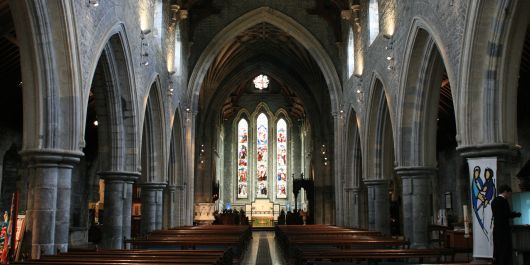
The history of the building itself, long and varied, began - at least according to legend - in the Sixth Century with the establishment of a monastery there by St Canice, Kilkenny's patron saint. Inside the building you will find the tomb of Bishop Ledrede. In the 14th Century, the bishop accused Alice Kyteler of witchcraft. The first person in the Irish records condemned for Witchcraft
Reach the top of the round tower by climbing the steep ladders with 121 steps. The view that awaits is worth the effort. Children under 12 are not allowed to make the climb.
Check if any music events are happening during your stay & experience the cathedral's natural acoustics.
The Cathedral and round tower can get busy and are operated on a first-come, first-served basis. An early visit is advised. You can get information leaflets in 15 different languages at the ticket desk.
You can visit St Canice's Cathedral seven days a week. Last admission is always 30 minutes before closing.
From October to March opening hours are 10:00 to 16:00 (Monday to Saturday) and 14:00 to 16:00 (Sunday).
In April, May & September opening hours are 10:00 to 17:00 (Monday to Saturday) and 14:00 to 17:00 (Sunday).
From June to August opening hours are 09:00 to 18:00 (Monday to Saturday) and 13:00 to 18:00 (Sunday).
Admission to the Cathedral is €4.50 for everyone over 16. Students will pay €4. A family ticket for 2 adults and 2 children can be bought for €12. You can also purchase a combination ticket for the cathedral and tower climb for €6.50.
Founded in the second half of the Twelfth century and recently partially restored, Jerpoint Abbey is one of Ireland's finest Cistercian ruins. It is located close to Thomastown in County Kilkenny. The main church, with its Romanesque flourishes, dates from these earliest days in the abbey's long history, but visitors will also find tombs dating from the thirteenth and sixteenth centuries, the tower and the cloisters date back to the fifteenth century. Look out for figures carved into the cloister pillars, some of them are quite entertaining.
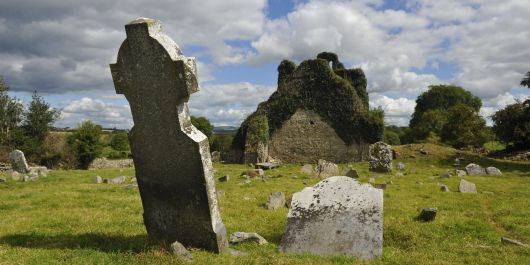
The abbey itself was built around 1180 and was dedicated to the Virgin Mary. Jerpoint Abbey continued to prosper until the English King, Henry VIII, called for the 'Dissolution of the Monasteries' between 1536 and 1541. The last abbot of the abbey, Oliver Grace, surrendered it to the king during this time. Since 1880, Jerpoint Abbey has been classified as a national monument and has been in the care of the Office of Public Works.
Drivers should note that the free-to-use car park entrance/exit is on a blind bend. Take care when leaving!
A guided tour will help bring the history of the site to life.
You will find the Abbey 2.5 km southwest of Thomastown. There are guided tours available and you will find an excellent exhibition in the visitor centre. For the children, there is a treasure hunt with saints, knights mythological creatures and more available in the visitor centre. The recommended duration of your visit would be around an hour.
During December to March a visit is possible by pre-booked tours only. Jerpoint Abbey is closed for the Christmas period.
From early March to September opening hours are 09:00 to 17:30 daily.
In October opening hours are 09:00 to 17:00 daily.
From November to the beginning of December opening hours are 09:30 to 16:30 daily.
An adult ticket can be purchased for €5 and a ticket for a child for €3.
A secluded seaside village in Waterford, Ardmore attracts summer visitors to its long, sandy beach, as well as its cliff walks, shops and early Christian monuments. Visitors should add to their to-do list any and all of the following depending on your interests and group make-up: St Declan's Cathedral and Round Tower, Ballyquin Beach and Ardmore Pottery which will leave you well placed to finish the day with a cliff-top stroll before dinner.
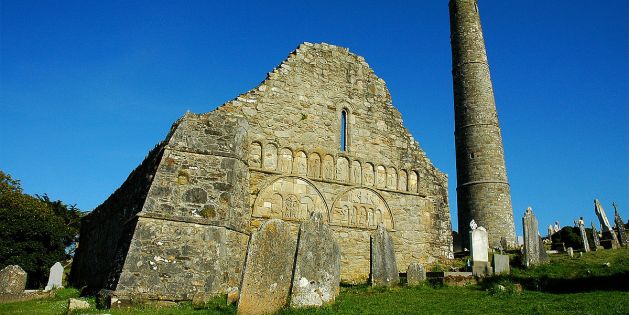
Ardmore's clifftop hotels offer unbeatable views to anyone looking to spend the night in this charming village retreat.
Dungarvan is a harbour town located at the heart of County Waterford, nestled beneath the Comeragh mountains. It has a population of just over 9,000 people, which increases significantly during the summer months. An excavation in Dungarvan, in the late 1800s, unearthed Ireland's only ever recording of Mammoth elephant bones. The town became one of Ireland's first urban centres, after a large Anglo-Norman fortification was established here in the 12th century. In 1649, Oliver Cromwell chose not to attack the town after a woman offered him wine as his army marched across the city gates.
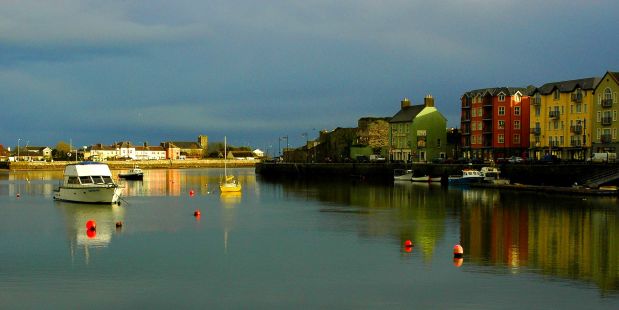
Over recent years, Dungarvan has gained a reputation as a must-see destination for all foodies visiting Ireland, it is home to the regular farmers' market, the Waterford Festival of Food, and the Tannery Restaurant & Cooking School.
If you're feeling active, Dungarvan is the starting point for the popular Waterford Greenway cycle route. In addition to the great food, a day of rest here offers a wealth of good horticulture, art and retail therapy. There are also three golf courses within a 10-minute drive of the town.
This stunning region of south-east Ireland was declared a European Geopark in 2001 and a UNESCO Global Geopark in 2004. It earned its name following generations of metal-mining industry, the legacies of which now make the region such a tourist attraction. Today, it retains all of its geological diversity, with various marked walking trails offering unique access to this most charming face of Ireland stretching over 17kms of rugged coastline from Kilfarrasy to Stradbally.
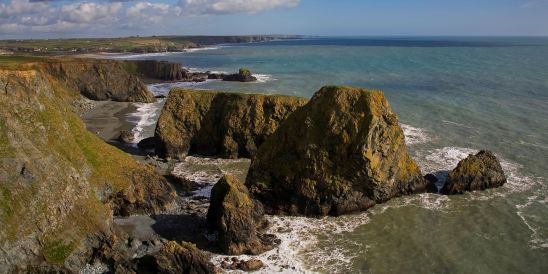
Visit the exhibition, suitable for all ages, at Copper Coast Geopark centre to learn more about the history of copper mining and the geology of the area. Pick up one of the walking trail cards there as well on the different trails and walks near Annetstown, Boastrand, Bunmahon, Dunhill, Fenor, Stradbally... Audio tours and guide services on the trails of the Copper Coast are also available.
This iconic setting is unspoiled by retail, so bring everything you need including cash for a quick stop at Tom Hayes Pub.

With its close proximity to Ireland's southeast, Dublin Airport is the ideal first stop on your visit. There is a great road network connecting the southeast to Dublin city. You can rent a car from the numerous companies in Dublin Airport and travel to Waterford City on the M9 motorway (2 hours), Rosslare in County Wexford on the M11 (2 hours) and Kilkenny City via the M9 (1 hour 30 minutes).
There are two bus services running from Dublin Airport to Waterford City (Route 4 by Expressway for €15.50 and the 736 by JJ Kavanagh for €18).
To get the train from Dublin Airport to the southeast would involve making your way into Dublin City. There are multiple bus services to the city provided by Aircoach, Airlink, Dublin Bus and GoBus. From there you can jump on a train from Connelly Station or Heuston Station to your chosen destination in the southeast.
The main bus station in Waterford City is located on the quays, in the city centre. Wexford's main bus stations are in Wexford Town centre and Rosslare Harbour. Kilkenny City's main bus station is located in the city centre, outside the main train station.
Bus journey times from Dublin City:
| Destination | Time |
|---|---|
| Kilkenny City | 50 minutes |
| Wexford Town | 2 hours |
| Waterford City | 2 hours and 40 minutes |
While there is a rail network across Waterford, Wexford and Kilkenny. Most people travelling in and out of the region would rarely take the train. The bus is seen as the more cost-effective and hassle-free option. The main train stations of the southeast are located in Waterford City, Kilkenny City and in Wexford Town.
Driving into Waterford City from the west, that is to say, coming from Cork or Kerry and travelling along the N25 and R680, you will be greeted with a stretch of road that seems to have an endless supply of roundabouts. This is definitely not the route to take if you are learning the delicate art of the roundabout. Top tip: to avoid 7 of them you can take a shortcut at Dungarvan along the R911 to Southways.
Heading to Waterford from Dublin is a little more straightforward. From the N7, after Naas in County Kildare, you take the N9 due south to Waterford. The tricky part about driving from Dublin City is getting out of Dublin City. Make sure, if you are booking a rental car to ask for a Sat-Nav. The route is the same from Dublin City to Kilkenny City except when you reach Naas, from here you go from the N7 to the M7 and then onto the N77. Driving to Wexford from Dublin involves taking the M50 all the way out of Dublin and connecting with the M11 motorway.
Rosslare Harbour is serviced by a number of bus routes. The main bus route is the number 40, providing several services per day via New Ross in County Wexford to/from Waterford City, Cork City, Killarney and Tralee. There are also trains running twice a day from Rosslare Harbour to Dublin's Connolly and Hueston stations, these trains take around 3 hours and cost on average 17 euro one-way.
Rosslare Harbour services ports in Wales and France.
| Wales | France |
|---|---|
| Fishgaurd | Cherbourg |
| Pembroke | Roscoff |